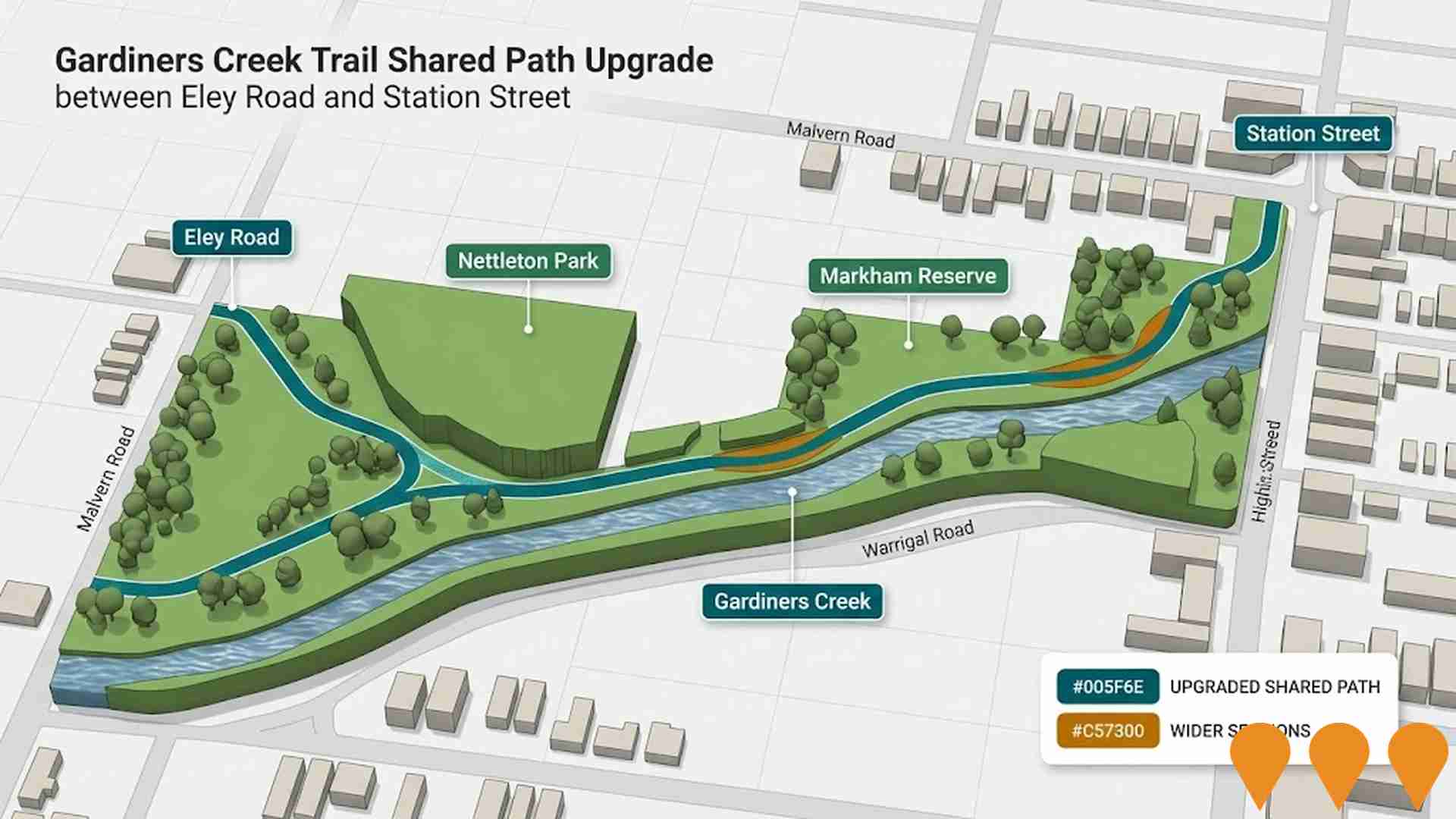Chart Color Schemes
est. as @ -- *
ABS ERP | -- people | --
2021 Census | -- people
Sales Activity
Curious about local property values? Filter the chart to assess the volume and appreciation (including resales) trends and regional comparisons, or scroll to the map below view this information at an individual property level.
Find a Recent Sale
Sales Detail
Population
Population growth drivers in Burwood are strong compared to national averages based on AreaSearch's ranking of recent, and medium to long-term trends
Burwood, Victoria's population was 14,994 as of August 2025. This showed an increase of 2,658 people since the 2021 Census, which recorded a population of 12,336. The change was inferred from ABS estimated resident population of 14,918 in June 2024 and additional validated new addresses since the Census date. This resulted in a density ratio of 2,975 persons per square kilometer, placing Burwood in the upper quartile nationally according to AreaSearch assessments. Burwood's growth rate of 21.5% since the 2021 census exceeded both its SA4 region (8.1%) and the national average. Overseas migration contributed approximately 97.5% of overall population gains during recent periods, driving this growth.
AreaSearch uses ABS/Geoscience Australia projections for each SA2 area released in 2024 with a base year of 2022. For areas not covered by this data, AreaSearch utilises Victorian Government's Regional/LGA projections from 2023 with adjustments made via weighted aggregation of population growth from LGA to SA2 levels. Growth rates by age group are applied across all areas for the years 2032 to 2041. Future trends suggest a significant population increase in Burwood, expected to expand by 4,835 persons by 2041 based on latest numbers, recording a gain of 31.7% over these 17 years.
Frequently Asked Questions - Population
Development
AreaSearch assessment of residential development activity positions Burwood among the top 25% of areas assessed nationwide
Burwood averaged approximately 74 new dwelling approvals per year. Between FY-21 and FY-25372 homes were approved, with an additional 23 approved so far in FY-26. This results in around 4 new residents arriving per year for each dwelling constructed during these years.
Consequently, demand significantly exceeds supply, leading to price growth and increased buyer competition. The average construction value of new properties is $766,000, indicating a focus on the premium market segment by developers. In FY-26, commercial approvals totaled $62.6 million, suggesting strong local business investment. Compared to Greater Melbourne, Burwood has approximately two-thirds the rate of new dwelling approvals per person and ranks in the 56th percentile nationally when measured against other areas assessed. The current building activity shows 34.0% detached dwellings and 66.0% attached dwellings, reflecting a shift towards compact living that offers affordable entry pathways for downsizers, investors, and first-time purchasers.
This change is notable compared to the current housing mix of 55.0% houses. With around 276 people per dwelling approval, Burwood exhibits a developing market. Population forecasts project an increase of 4,759 residents by 2041. At current development rates, housing supply may struggle to keep pace with population growth, potentially intensifying buyer competition and supporting price increases.
Frequently Asked Questions - Development
Infrastructure
Burwood has strong levels of nearby infrastructure activity, ranking in the top 30% nationally
Changes to local infrastructure significantly impact an area's performance. AreaSearch has identified 16 projects likely to affect the area. Notable ones include the Burwood Heights Activity Centre Structure Plan, the development at 145-155 Burwood Highway, the Suburban Rail Loop East - Burwood Station project, and the development at 133 Burwood Highway. The following list details those most relevant.
Professional plan users can use the search below to filter and access additional projects.
INFRASTRUCTURE SEARCH
 Denotes AI-based impression for illustrative purposes only, not to be taken as definitive under any circumstances. Please follow links and conduct other investigations from the project's source for actual imagery. Developers and project owners wishing us to use original imagery please Contact Us and we will do so.
Denotes AI-based impression for illustrative purposes only, not to be taken as definitive under any circumstances. Please follow links and conduct other investigations from the project's source for actual imagery. Developers and project owners wishing us to use original imagery please Contact Us and we will do so.
Frequently Asked Questions - Infrastructure
Suburban Rail Loop East - Burwood Station
New underground station as part of the Suburban Rail Loop East project, located opposite Deakin University. The station will feature a 94m long platform about 18m below ground, with lifts and escalators. The project includes a pedestrian overpass to Deakin University, a new bus interchange on Sinnott Street, and 750 bike parking spaces. Major construction, including site preparation for the Tunnel Boring Machine (TBM) launch site, is underway. Two TBMs will launch from Burwood towards Glen Waverley in 2026, with trains expected to be operational in 2035.
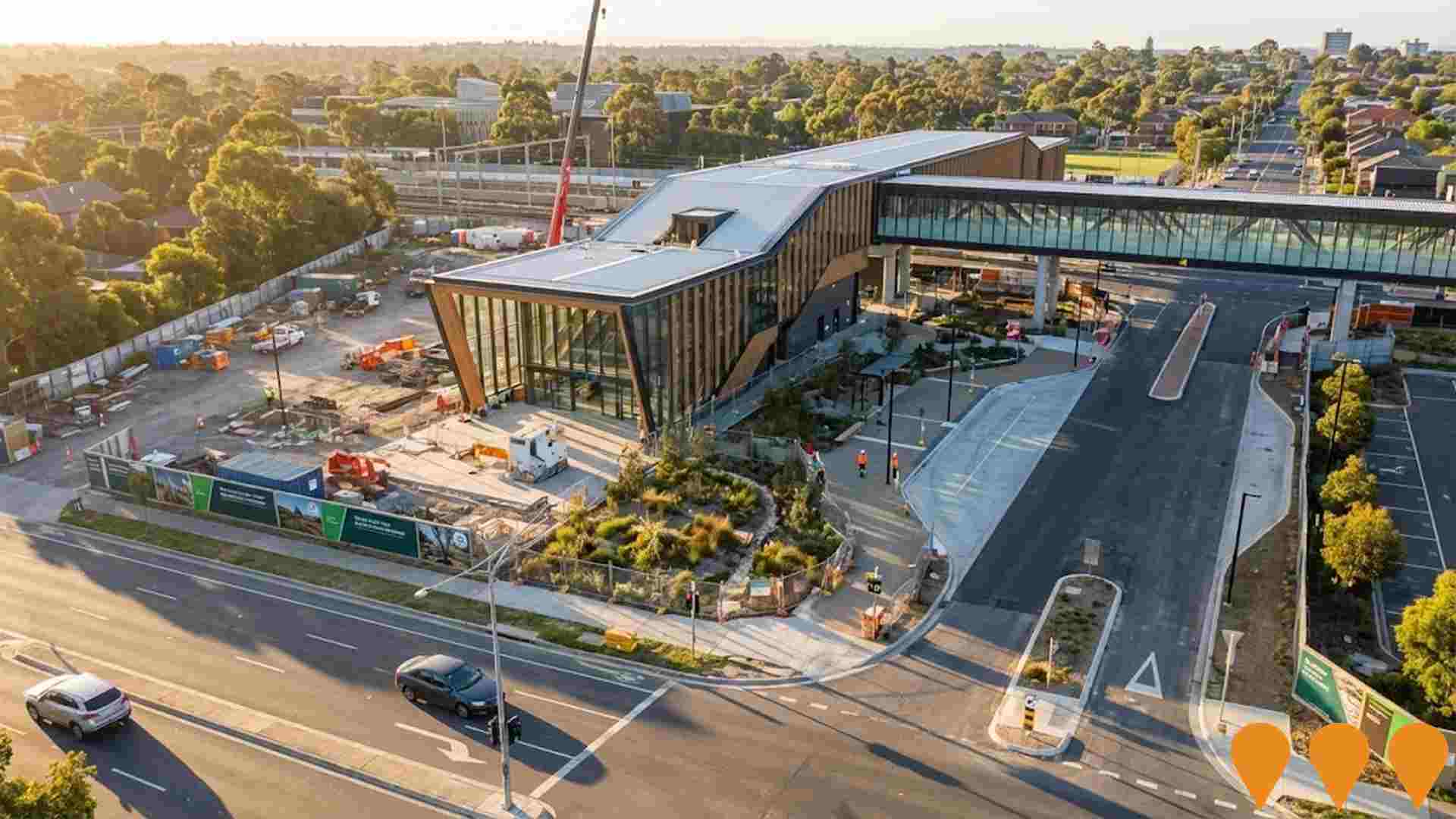
Burwood Heights Activity Centre Structure Plan
The Structure Plan guides future development and improvement of the Burwood Heights Major Activity Centre, consistent with its Major Activity Centre status in metropolitan planning strategies. It establishes a vision and local planning policies for the activity centre, which includes the former 20.5ha Former Brickworks site (now Frasers Property Australia's Burwood Brickworks development) and the existing shopping centre. The Structure Plan has been incorporated into the Whitehorse Planning Scheme.

Burwood Brickworks
A 20.5-hectare master-planned community by Frasers Property featuring 753 dwellings (townhomes, apartments, and land lots) and the award-winning Burwood Brickworks Shopping Centre, the first retail centre globally to achieve Living Building Challenge Petal Certification. The precinct achieved a 6 Star Green Star Communities rating and includes 2.5 hectares of parkland (including Middleborough Reserve), an urban plaza, a rooftop urban farm, and over 40 specialty retailers. The shopping centre opened in December 2019, with the broader residential and public realm works completed by early 2024.
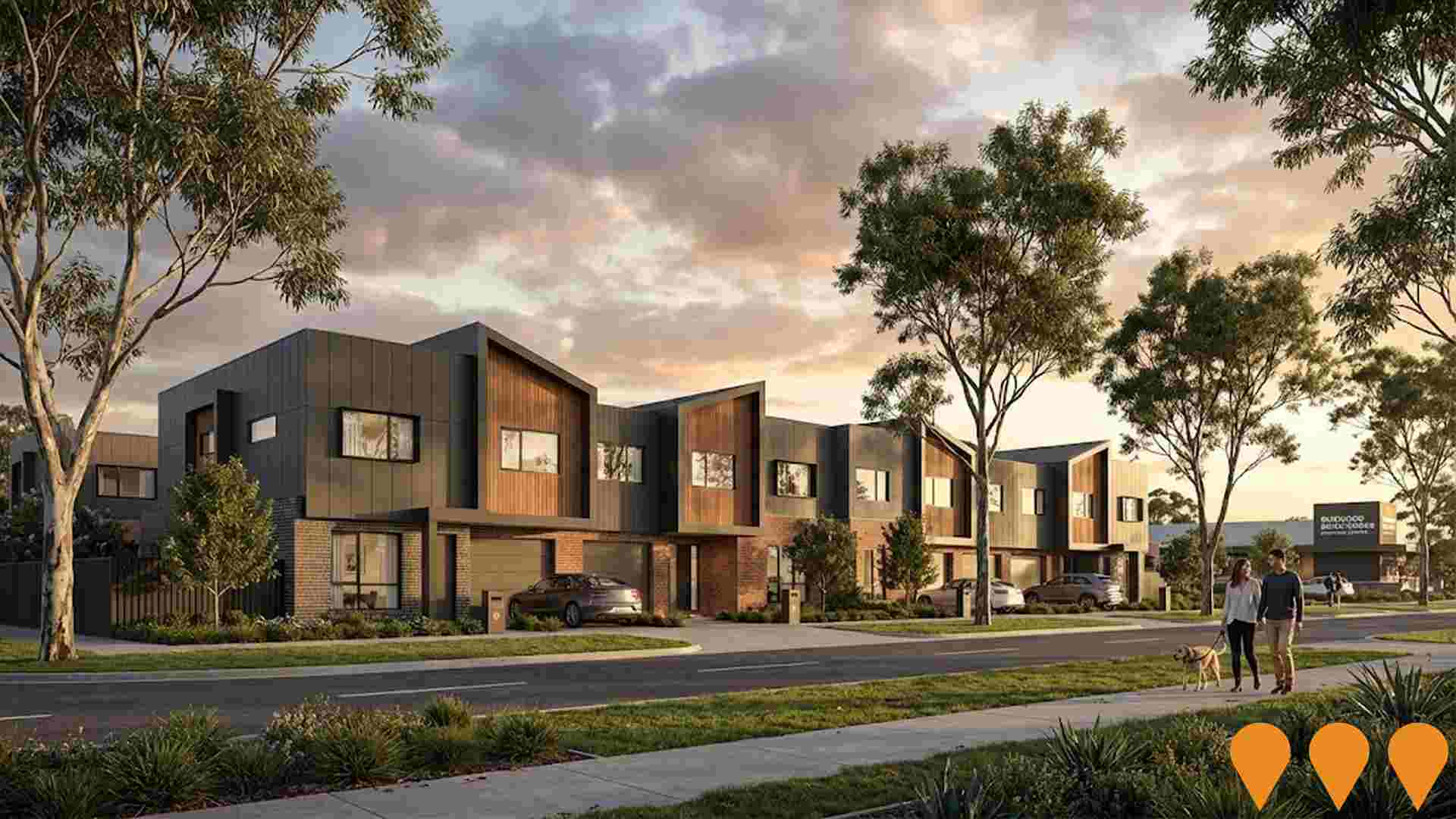
Deakin University Law School Building
Nine-level, 20,000 sqm law school building featuring flexible learning spaces, student support services, and sustainable design. Achieved 5 Star Green Star rating with rooftop solar panels and rainwater harvesting. Innovative design replaces traditional lecture theatres.
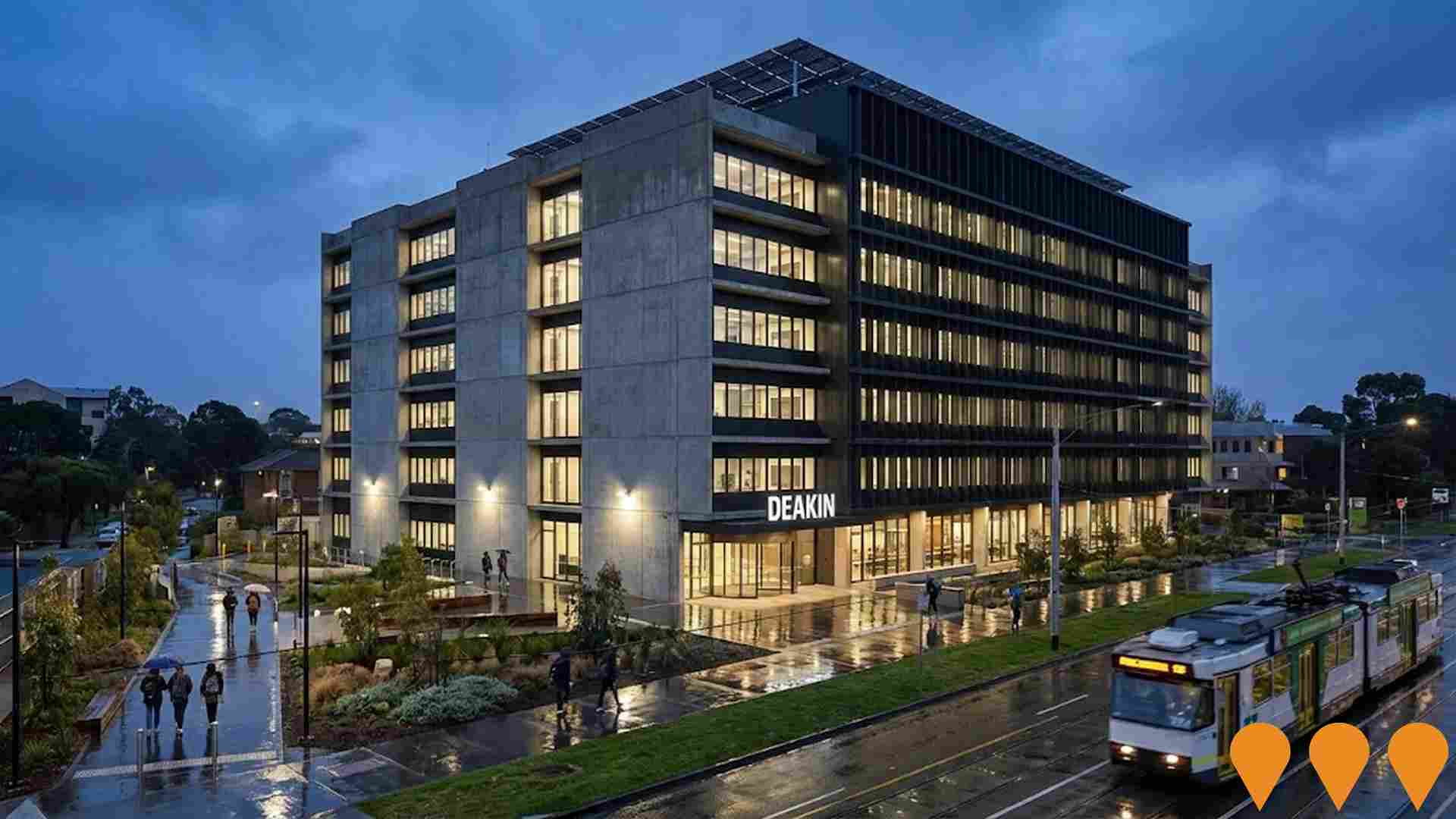
Markham Avenue Social and Affordable Housing
178 social and affordable homes across five buildings (3-4 storeys) designed by Architectus. Features 111 social housing and 67 affordable dwellings with sustainable design and biodiversity protection. Tenure-blind development with universally accessible design.
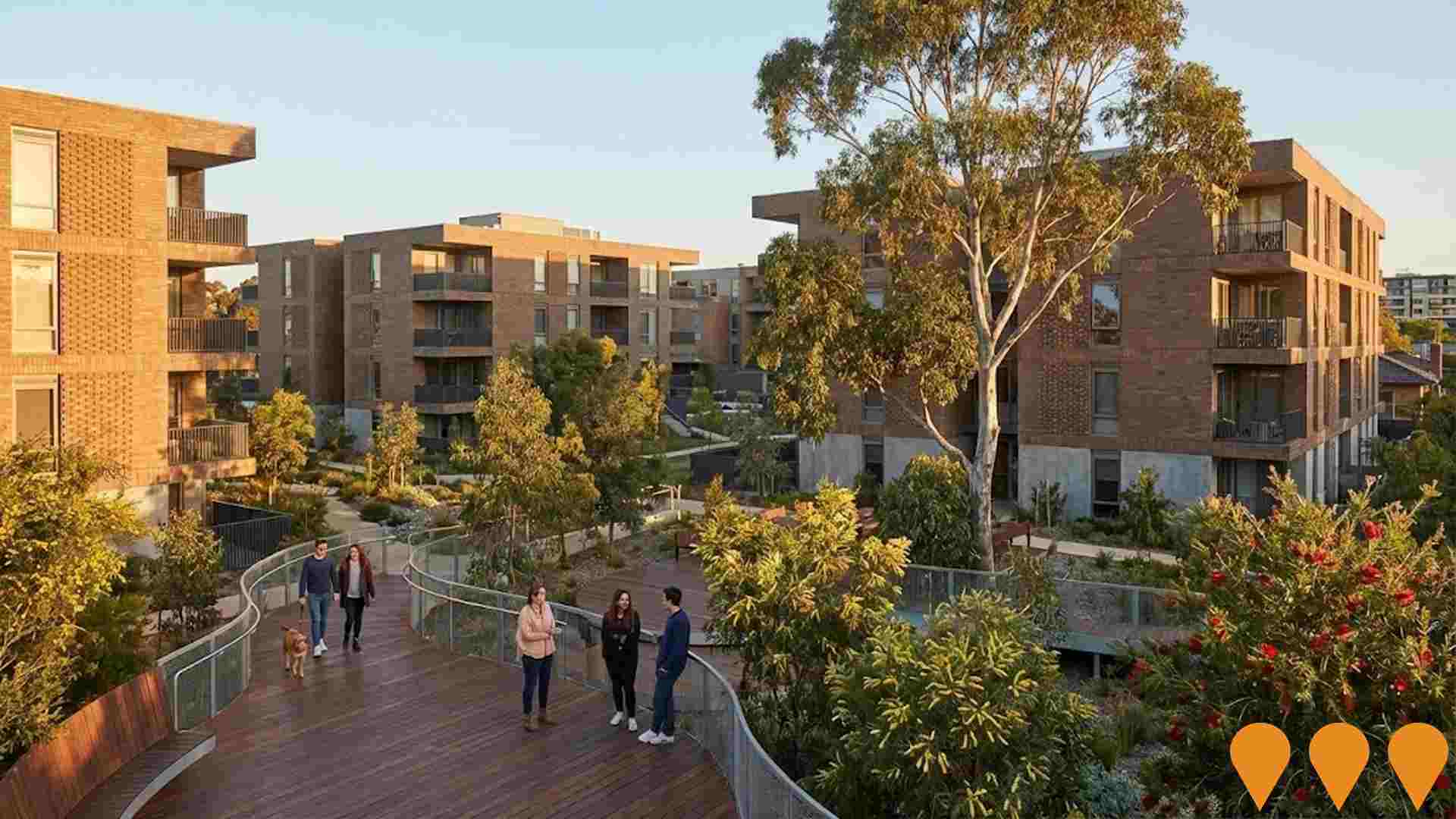
Roberts Reserve Masterplan & Sports Pavilion
Major upgrade to Roberts Reserve in Box Hill South, delivering a new community sports pavilion with modern change rooms and social space, improved sports fields and courts, upgraded paths and lighting, and more accessible open space for local clubs and residents.
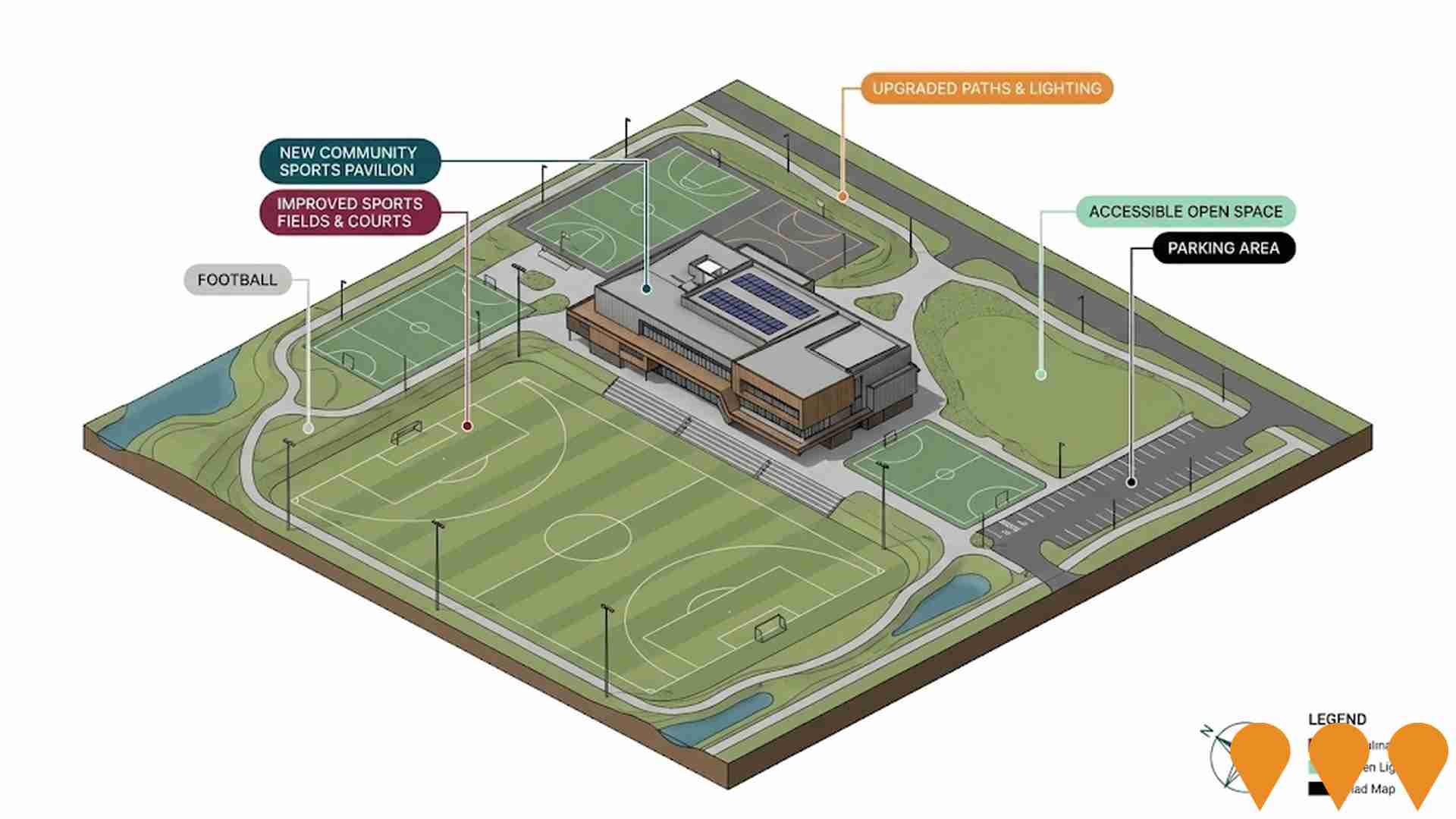
145-155 Burwood Highway Development
Mixed-use development featuring 285 apartments across two towers (12 and 15 storeys) with ground floor retail and basement parking. Transit-oriented design positioned for future Suburban Rail Loop connectivity.
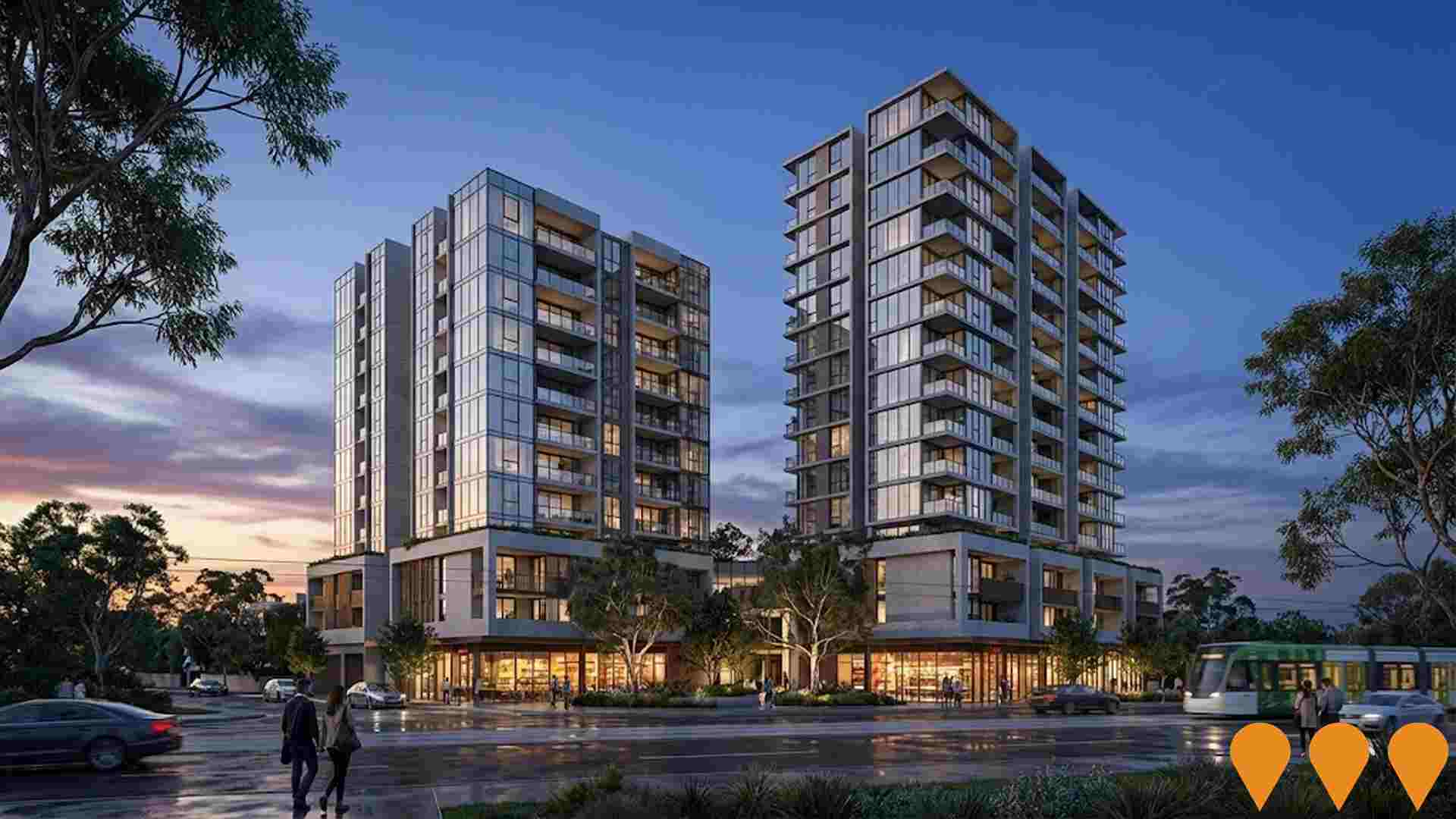
Ashburton Library and Community Centre
New integrated library and community centre facility featuring modern library services, community meeting rooms, technology spaces, and cultural programming areas. Designed as a community hub for lifelong learning.
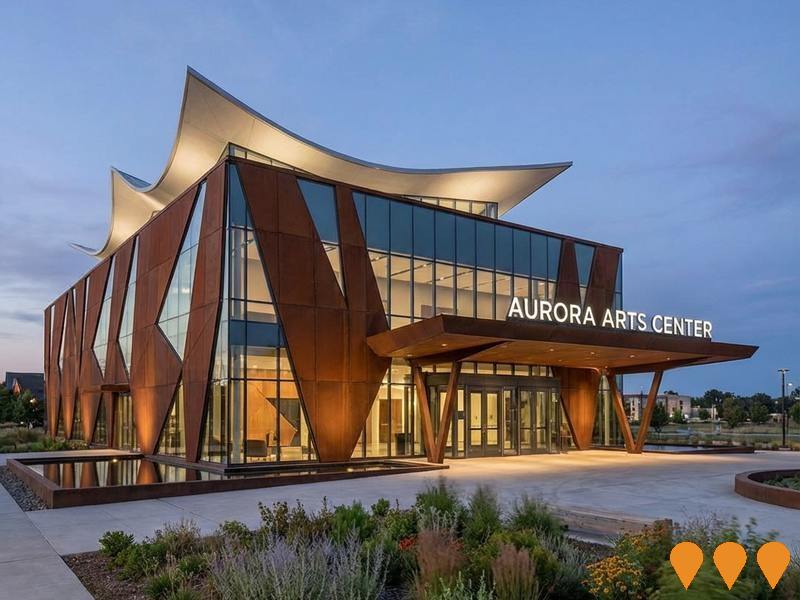
Employment
The employment landscape in Burwood shows performance that lags behind national averages across key labour market indicators
Burwood Vic has highly educated workforce with professional services strongly represented. Unemployment rate was 4.9% as of June 2025.
Employment growth over the past year was estimated at 4.4%. As of June 2025, 8,085 residents were in work while unemployment rate was 4.6%, 0.3% above Greater Melbourne's rate. Workforce participation was 59.1%, below Greater Melbourne's 64.1%. Leading employment industries among residents comprised health care & social assistance, retail trade, and education & training.
Accommodation & food showed strong specialization with an employment share of 1.5 times the regional level. Construction had limited presence at 6.2% compared to 9.7% regionally. The worker-to-resident ratio was 0.6, indicating above-normal local employment opportunities. Over the 12 months to June 2025, employment increased by 4.4% while labour force grew by 3.1%, causing unemployment rate to fall by 1.2 percentage points. In Greater Melbourne, employment rose by 3.5%, labour force grew by 4.0%, and unemployment rose by 0.5 percentage points. Jobs and Skills Australia's national employment forecasts from May 2025 project national employment growth of 6.6% over five years and 13.7% over ten years, with varying rates between industry sectors. Applying these projections to Burwood's employment mix suggests local growth of approximately 6.8% over five years and 13.9% over ten years.
Frequently Asked Questions - Employment
Income
Income levels sit below national averages according to AreaSearch assessment
AreaSearch released postcode level ATO data for financial year 2022. Burwood had a median taxpayer income of $44,956 and an average of $65,067. Nationally, the median was $48,136 and the average was $71,452. Greater Melbourne's median was $54,892 with an average of $73,761. Based on Wage Price Index growth since financial year 2022 until September 2025 (an increase of 12.16%), Burwood's estimated median income would be approximately $50,423 and the average around $72,979. Census data shows individual incomes at the 17th percentile ($637 weekly), while household incomes are at the 39th percentile. The earnings profile indicates that 27.6% of residents (4,138 people) fall into the $1,500 - 2,999 income bracket. This is similar to regional levels where 32.8% occupy this range. Housing affordability pressures are severe with only 79.5% of income remaining after housing costs, ranking at the 35th percentile. Burwood's SEIFA income ranking places it in the 7th decile.
Frequently Asked Questions - Income
Housing
Burwood displays a diverse mix of dwelling types, with a higher proportion of rental properties than the broader region
Burwood's dwelling structure, as per the latest Census, had 55.4% houses and 44.6% other dwellings (semi-detached, apartments, 'other' dwellings), compared to Melbourne metro's 60.2% houses and 39.8% other dwellings. Home ownership in Burwood stood at 31.4%, with mortgaged dwellings at 27.2% and rented dwellings at 41.4%. The median monthly mortgage repayment was $2,457, higher than Melbourne metro's $2,300. Median weekly rent in Burwood was $401, slightly above Melbourne metro's $412. Nationally, Burwood's mortgage repayments were significantly higher at $2,457 compared to the Australian average of $1,863, and rents were also higher at $401 versus the national figure of $375.
Frequently Asked Questions - Housing
Household Composition
Burwood features high concentrations of group households, with a lower-than-average median household size
Family households constitute 60.5% of all households, including 25.4% couples with children, 22.5% couples without children, and 10.6% single parent families. Non-family households comprise the remaining 39.5%, with lone person households at 29.6% and group households comprising 9.9%. The median household size is 2.4 people, which is smaller than the Greater Melbourne average of 2.5.
Frequently Asked Questions - Households
Local Schools & Education
Educational achievement in Burwood places it within the top 10% nationally, reflecting strong academic performance and high qualification levels across the community
Educational attainment in Burwood is notably high with 47.3% of residents aged 15+ holding university qualifications compared to the national average of 30.4% and the Victorian average of 33.4%. Bachelor degrees are the most common at 28.1%, followed by postgraduate qualifications (15.8%) and graduate diplomas (3.4%). Vocational pathways account for 20.8% of qualifications, with advanced diplomas making up 10.8% and certificates 10.0%. Educational participation is high, with 37.7% of residents currently enrolled in formal education, including 18.2% in tertiary, 7.0% in secondary, and 6.1% pursuing primary education.
Burwood's five schools have a combined enrollment reaching 3,123 students as of the latest available data. The area demonstrates significant socio-educational advantages with an ICSEA score of 1139. The educational mix includes two primary, one secondary, and two K-12 schools. School capacity exceeds typical residential needs at 20.8 places per 100 residents compared to the regional average of 14.5, indicating that Burwood serves as an educational center for the broader region.
Frequently Asked Questions - Education
Schools Detail
Nearby Services & Amenities
Transport
Transport servicing is high compared to other areas nationally based on assessment of service frequency, route connectivity and accessibility
Transport analysis indicates 76 active stops operating within Burwood. These include lightrail and bus services. There are 16 routes serving these stops, collectively facilitating 6532 weekly passenger trips.
Transport accessibility is rated good, with residents typically located 204 meters from the nearest stop. Service frequency averages 933 trips per day across all routes, equating to approximately 85 weekly trips per individual stop.
Frequently Asked Questions - Transport
Transport Stops Detail
Health
Burwood's residents are extremely healthy with younger cohorts in particular seeing very low prevalence of common health conditions
Analysis of health metrics shows strong performance throughout Burwood. Younger cohorts particularly have a very low prevalence of common health conditions.
The rate of private health cover is approximately 52% of the total population (~7,781 people), leading that of the average SA2 area but slightly lower than Greater Melbourne's 56.0%. Mental health issues and asthma are the most common medical conditions in the area, impacting 7.4 and 6.1% of residents respectively. A majority, 74.4%, declared themselves completely clear of medical ailments, compared to 73.9% across Greater Melbourne. As of 2016 data, Burwood has 13.9% of residents aged 65 and over (2,088 people), which is lower than Greater Melbourne's 17.7%. Despite this, health outcomes among seniors require more attention than the broader population.
Frequently Asked Questions - Health
Cultural Diversity
Burwood is among the most culturally diverse areas in the country based on AreaSearch assessment of a range of language and cultural background related metrics
Burwood has a high level of cultural diversity, with 49.0% of its population speaking a language other than English at home and 50.7% born overseas. Christianity is the main religion in Burwood, making up 39.2% of people. However, Buddhism is overrepresented, comprising 7.3% of the population compared to 6.0% across Greater Melbourne.
The top three ancestry groups are Chinese (21.1%), English (16.4%), and Australian (14.7%). Some ethnic groups have notable representation differences: Sri Lankan at 1.7% (regional average 0.8%), Greek at 3.7% (vs regional 3.0%), and Indian at 5.9% (regional average 3.7%).
Frequently Asked Questions - Diversity
Age
Burwood's young demographic places it in the bottom 15% of areas nationwide
Burwood's median age is 31 years, lower than Greater Melbourne's average of 37 and Australia's median of 38. Burwood has a higher percentage of residents aged 15-24 (28.7%) compared to Greater Melbourne but fewer residents aged 5-14 (6.6%). This 15-24 concentration is significantly higher than the national average of 12.5%. Between 2021 and present, younger residents have decreased Burwood's median age by 2.4 years to 31. During this period, the 15-24 age group grew from 21.1% to 28.7%, while the 25-34 cohort increased from 19.3% to 20.4%. Conversely, the 45-54 cohort declined from 10.8% to 8.8%, and the 5-14 group decreased from 8.4% to 6.6%. Population forecasts for 2041 suggest substantial demographic changes in Burwood. The 25-34 age cohort is projected to grow by 1,398 people (46%), increasing from 3,054 to 4,453 residents.


